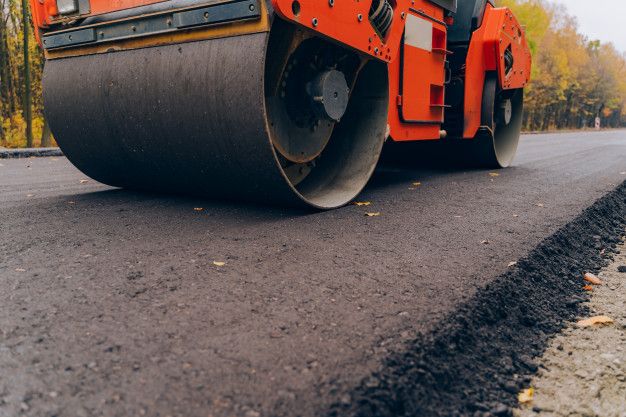
General Description of Polymer Modified Bitumen (PMB)
Polymer Modified bitumen (PMB) is one of the specially designed and engineered bitumen grades that are used in making pavement, roads for heavy-duty traffic, and home roofing solutions to withstand extreme weather conditions. This material is also used as a sealant in residential roofing applications.
consists of bitumen blended with a synthetic polymer or crumb rubber. PMBs are used to enhance the performance of binders on heavily trafficked or distressed pavement surfaces, often in adverse climatic conditions. Property improvements include reduced temperature susceptibility, increased elasticity or resilience, increased cohesion, and improved tenacity once a bond has been established. as a valued engineering material continues to increase. The interest in the modification of bitumen using polymers, whether virgin, scrap, or polymer blends, is intense.
Production of hot asphalt mixes with Polymer modified Bitumen (PMB) is mandatory for enhancing the performance of bitumen used in road, runway, and racetrack applications both by improving life expectancy and reducing maintenance levels.
There are 4 important issues for good quality PMB:
Bitumen quality, polymer compatibility (the most used polymer is SBS), mill performance (a high-quality mill with high power is fundamental to grant the perfect blending of polymer and bitumen), and good agitation of the final product (which is guaranteed by two agitators in each tank).
However, it is brittle in cold environments and softens readily in warm environments. One of the many methods employed to toughen bitumen is to blend it with polymers, either virgin or scrap, to produce (PMB) . A lowering of the breaking point (DIN 52 012) and an increase in ductility (DIN 52 013) by polymer additive show better cold flexibility and are called polymer modified bitumen.
If you are more interested in product information or need to place an order contact or inquire about our Sales team.
Application of Polymer Modified Bitumen
- Higher rigidity
- Increased resistance to deformation
- Increased resistance to cracks and stripping
- Better water resistance properties
- High durability
Advantages of Polymer Modified Bitumen
- Higher Resistance to Deformation at Hight Temperature
- Enhanced Deformation Resistance to Low Temperature Cracking ‘ Improve Temperature
- Susceptibility
- Improved Aging Resistance
- Improved Adhesion between Aggregate and Binder
- Higher Fatigue Life of Mixes
- Delay in Thermal/ Reflective Cracking
- Over all Extended Pavement Surface Life
- Savings in Total Roadd Life Coasting.
- Improved Binder Film Thickness
- Improved Cohesion
- Improved Workability
- Improved Fuel Resistance
- Improved Water Resistance
- Not detrimental to basic properties of Bitumen and Enhances the
Usage of Polymer Modified
Polymer Modified Bitumen can be used in asphalt mix designs which results in the manufacture of cohesive asphalt mix with good elasticity suitable for type of traffic. Special attention to be taken to the temperatures while manufacturing, lying and compaction are performed.
Specification of Polymer Modified Bitumen (PMB)
analyze
| Property | Test Method | PG76S-10 | PG76H-10 | PG76V-10 | PG-76E-10 |
|---|---|---|---|---|---|
| Flash Point,min,°C | ASTMD92 | 230 | 230 | 230 | 230 |
| Viscosity @ 135°C, max,Pa.s | ASTMD4402 | 3.00 | 3.00 | 3.00 | 3.00 |
| Dianamic Shear, G*/sino@ 760C and 1 O rad/s min,kPa | ASTM 0717S | 1.00 | 1.00 | 1.00 | 1.00 |
| Seperation test : Absalute difference between G* @76°C and 10rad/s of Top and Bottom Specimens, Max,%1h1 | ASTM 07173 | 20 | 20 | 20 | 20 |
| Time Stebility : Average of G* values measured in Seperation test (Item 6) divided by the initial G* value measured in (item 5), range 111 | _____________ | 0.8-1.2 | 0.8-1.2 | 0.8-1.2 | 0.8-1.2 |
| Particular Retained on Sieve Test, %U1 | PWA 100 | 0 | 0 | 0 | 0 |
| Solubility, Min,% | ASTMDSS46 | 99 | 99 | 99 | 99 |
| Polymer Contest, min o/o by mass Supplier Certificate Required | 2 | 2.0 | 3.0 | 3.0 |
|
PMB 40
| Test Perfomed | Result | Test Method |
|---|---|---|
| Penetration@ 25 c, I00gr, 5s , 0.1 mm | 35 | ASTMDS |
| Flash point , c | 308 | ASTM D92 |
| Elastic Reco\'cry of Hair Thread@ 15 •c , % Min | 79 | ASTM D6084 |
| Softening Point, •c | 69.5 | ASTM D36 |
| Separation Difference in Softening Point R&B, •c, Max | 0.9 | ASTM D7173 |
| Specific Gravity at 25 C (g/cmJ) | 1.01 | ASTM D70 |
| Dynamic Viscosily al IJSC (Brookfield Viscomeler) (Pa.s) | 1.89 | ASTM D4402 |
| Solubility in TCE (%) | 99.9 | ASTM D2042 |
| Reduction in Penetration of Residue,@ 25 •c, % to Original | 4.6 | ASTM D5 |
| Loss on Heating for 5 Hours@ 25 •c , % to Original | 0.07 | ASTM D1754 |
PMB 70
| Test Perfomed | Result | Test Method |
|---|---|---|
| Penetration@ 25 c, I00gr, 5s , 0.1 mm | 44 | ASTM DS |
| Flash point , c | 303 | ASTM D92 |
| Elastic Reco\'cry of Hair Thread@ 15 •c , % Min | 77 | ASTM D6084 |
| Softening Point, •c | 63 | ASTM D36 |
| Separation Difference in Softening Point R&B, •c, Max | 0.9 | ASTM D7173 |
| Specific Gravity at 25 C (g/cmJ) | 1.01 | ASTM D70 |
| Dynamic Viscosily al IJSC (Brookfield Viscomeler) (Pa.s) | 1.8 | ASTM D4402 |
| Solubility in TCE (%) | 99.9 | ASTM D2042 |
| Reduction in Penetration of Residue,@ 25 •c, % to Original | 4.4 | ASTM D5 |
| Loss on Heating for 5 Hours@ 25 •c , % to Original | 0.08 | ASTM D1754 |

